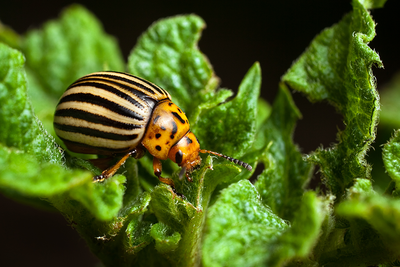Colorado Potato Beetles
About Colorado Potato Beetles
The Colorado potato beetle, Leptinotarsa decemlineata, is a serious insect pest of several vegetable crops in the family Solanaceae. Plants commonly attacked by this insect include potato, eggplant, tomato and pepper. Both the larval and adult stages feed on the leaves of plants, and if left unmanaged can quickly cause extensive defoliation. Under heavy infestations, feeding damage to above ground fruit may also occur.
 Colorado Potato Beetle Description
Colorado Potato Beetle Description
Adult Colorado potato beetles are approximately 3/8 of an inch long and oval in shape. They have yellowish-white wing covers (elytra) marked with ten longitudinal black stripes (five on each wing cover). Larvae are red to pinkish in color with two rows of black spots on each side of the body.
Colorado Potato Beetle Life Cycle
In West Virginia, this insect typically has two generations per year. Adults spend the winter in the soil or under crop residues and other organic debris. Adults become active in the spring (around May) and begin laying clusters of yellowish orange eggs on the undersides of leaves. After the eggs hatch, larvae feed for approximately two to four weeks before dropping to the ground to pupate in the soil. New adults typically emerge from the soil one week later to continue the next generation.
Colorado Potato Beetle Control
Chemical Control of Colorado Potato Beetles
Neonicotinoid insecticides (e.g., imidacloprid) applied at planting is the traditional method used by many West Virginians to control the Colorado potato beetle. However, the effectiveness of these insecticides has been waning in some parts of the U.S. due to resistance.
This insect has a long history of developing resistance to a number of the insecticide classes that have been used for its control. For instance, carbamate (e.g., carbaryl) and pyrethriod (e.g., permethrin) insecticides are now largely ineffective for controlling beetles. Rotating insecticides with different modes of action is essential for preventing, or at least delaying, the development of insecticide resistance. The spinosyn (e.g., spinosad, spinetoram) and diamide (e.g., chlorantraniliprole, cyantraniliprole) class of insecticides, as well as the active ingredients novaluron and abamectin, can be effective insecticide options for rotation.
Non-chemical Control of Colorado Potato Beetles
Non-chemical methods for management are also important. Selecting early-maturing cultivars and planting later in the season (June) may allow the harvest of crops before significant damage occurs.
If practiced on a regular basis, hand removal can be an effective method for controlling Colorado potato beetle in small plantings. The larvae and adults can be removed and placed in a container filled with water and a few drops of dish soap. The dish soap breaks the water’s surface tension so the insects sink into the water and drown rather than escape.
Another non-chemical method involves the use of a spring trap crop planted a few weeks before the main crop to divert overwintering beetle populations. These trap crops can then be destroyed (along with any beetles) before the primary crop becomes susceptible to attack.
Crop rotation may also be an effective option for larger growing areas. Growing susceptible crops only every other year, or planting these crops at least 1/4 to 1/2 mile away from the previous season’s crop may help reduce beetle populations.
Author: Daniel Frank, former WVU Extension Entomology Specialist
Last Reviewed: May 23, 2017